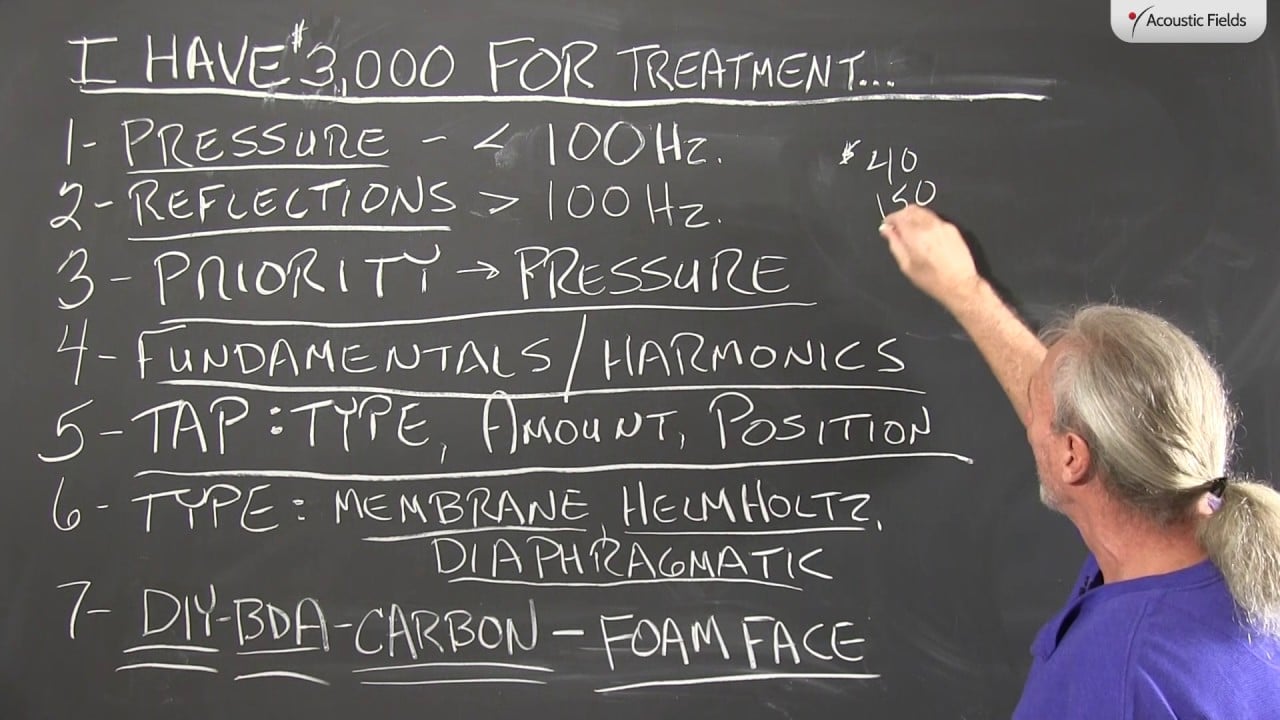I get a lot of people send me emails and phone calls and they say you know Dennis I don’t have a lot of money, I have 1,000 2,000 3,000 what can I do to treat my small room, I want to do something and I do have a carpentry skill set I can build things or I know someone who can build things for me so two areas we know from all the past videos I’ve done and I’m never ever going to change this paradigm, pressure and reflections. Everything less than 100 cycles is pressure; everything greater than 100 cycles is reflections because that’s the break points we use for treatment. Treatment below 100 requires special types and reflections above 100 require special rates and levels depending on usage so it’s two different kinds of treatment that’s why we use that as a break point in small room.
What does our priority have to be? It really doesn’t matter if you have 1,000 2,000 3,000 30,000 or 300 thousand, you got to get the low end under control, you just have no choice and that choice is even more restricted and limited in our small room. So pressure has to be our First choice below 100 cycles, what do we have for options? Well we know that energy has fundamentals and harmonics so our 40 cycle energy has 80 120 and 160 so we’ve got to deal with all of that because we want to keep that low end out of our mid ranges for sure. TAP is the acronym we’re going to use, type, amount and position; what type are we going to use, what amount, how many units and where we’re going to put them. So we have three types, we know this from my past videos, membrane, Helmholtz and diaphragmatic. Membrane and diaphragmatic are related, Helmholtz is that crazy device with the slit and the chamber and all that and it’s frequency specific, it’s hard to make and hard to tune and you need a lot of them because it covers such a narrow band, maybe 40 to 45 cycles. Membrane and diaphragmatic are more broadband in their approach so they cover a lot of frequencies, they do a little bit less at each octave but that’s okay because you get more coverage with wider range. Okay so we all know that we’ve taken diaphragmatic and expand upon its processes by adding our carbon technology so back to our original premise, we have 3000 what can we do? Well let me give you some ideas.
First we can go to the DIY section of our website and purchase the BDA unit; I think it’s about $40. That gives you the plans for building the unit, all right the materials for building the unit are about 150 so we got 190 in the whole deal and then you can continue on that way and build a diaphragmatic absorber for $250 a unit plus your labor so for $3,000 you could get 12 units which would be about right for any small room. Now if you wanted to build less units you could buy our carbon technology, carbon technology runs about $350 a unit so in round figures okay we’re about 550 here and then you include your labor so you’ll need less than 12 with the carbon probably eight. They’ll reduce the total amount by about 30% so all kinds of ways to go about this. Then if you spend maybe two thousand on the low end then you can start managing the reflection and the way you can do that is you can buy our phone technology which we all know I spent eight years trying to figure out, took me forever but the rates and levels of absorption are perfect for voice and music.
You can take the foam and put it on the face of each unit. The foam runs for about $75 on the face of each unit so now you’re what six and a quarter plus your labor and you got a nice unit that controls pressure and reflection. So sit down, define your strategy first look at your budget and go after the low frequency first.
—
This is an unedited transcript from our video series from Acoustic Fields. There will be some errors in grammar and sentence structure that occur during this translation process.
For complete understanding and comprehension, please view the video which is included in this text. For any additional information regarding this topic or others relating to room acoustics, please contact us directly at:
P: 520 – 392 – 9486







